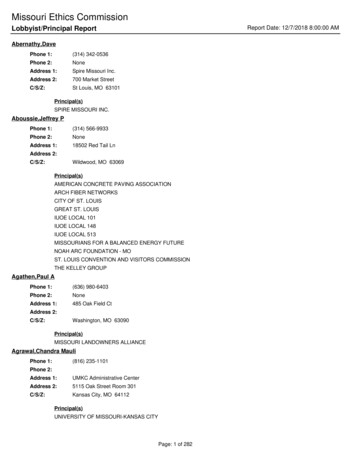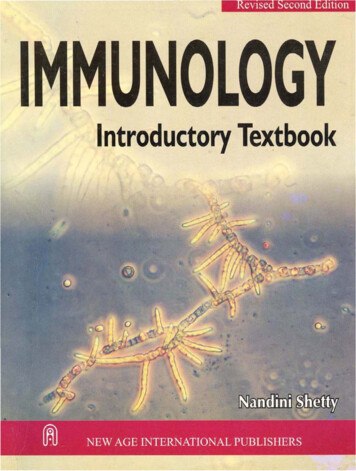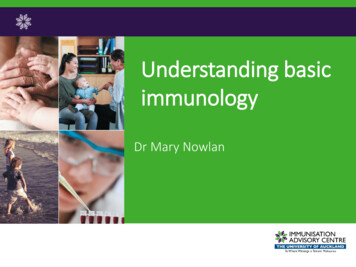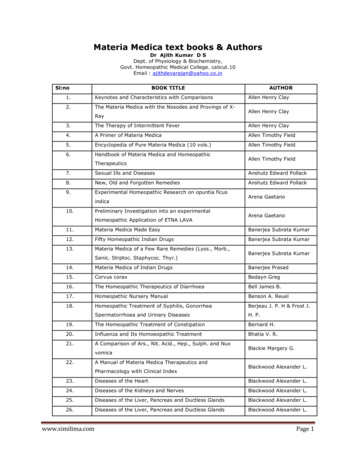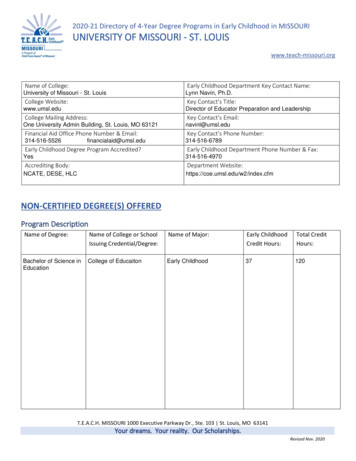
Transcription
BOLK’S COMPANIONSFOR THE STUDY OF MEDICINEIMMUNOLOGYSelf and Non-selffrom a PhenomenologicalPoint of ViewGuus van der Bie MD We wouldbe interestedto hear youropinion about this publication.You can let usknow at http://www.kingfishergroup.nl/questionnaire/
About the Louis Bolk InstituutThe Louis Bolk Institute has conducted scientificresearch to further the development of organic andsustainable agriculture, nutrition, and health care since1976. Its basic tenet is that nature is the source ofknowledge about life. The institute plays a pioneeringrole in its field by using experiential knowledge, bylooking at questions that consider data as part of agreater whole, and through national and internationalcollaboration. Through its groundbreaking researchthe Institute seeks to contribute to a healthy futurefor people, animals, and the environment. For theCompanions the Institute works together with theKingfisher Foundation.Publication number: GVO 05ISBN-10: 90-74021-36-0ISBN-13: 978-90-74021-36-4Price 10Postage 2KvK 41197208Triodos Bank 212185764IBAN nummer: NL77 TRIO 0212185764BIC-code/Swift code: TRIONL 2UFor credit card payment visit our website atwww.louisbolk.org/companionsFor further information:Louis Bolk InstituutHoofdstraat 24NL 3972 LA Driebergen, NetherlandsTel: ( 31) (0) 343 - 523860Fax: ( 31) (0) 343 - .euColofon: Louis Bolk Instituut, 2006Translation: Sandy ReijnhartCover: Fingerprint Cover painting by Pablo Picasso,Femme au miroir (Girl Before A Mirror), 1932,c/o Beeldrecht Amsterdam 2006
About the authorGuus van der Bie MD (1945) worked as a lecturerat the Department of Medical Anatomy andEmbryology at Utrecht State University, Hollandfrom1967 to1976. Next to his practice as a generalpractitioner since 1976, he continued to educatephysicians and therapists, and medical studentsat Utrecht State University and the University ofWitten/Herdecke, Germany. He is a member of theMedical Section of the School of Spiritual Science atthe Goetheanum, Dornach, Switzerland.About the projectThe project Renewal of Medical Education aim toproduce Companions that demonstrate how theinsights of current biomedical science can bebroadened by using the Goethean phenomenologicalmethod. This method innovates current conceptsand expands the understanding of biochemical,physiological, psychological, and morphologicalfactors in living organisms and their development intime and space, and in health, illness, and therapy.The project is commissioned by the KingfisherFoundation, which aspires the development,application, and publication of the Goetheanphenomenological research method in the widestsense, to complement and innovate the acceptedscientific view and research method.BOLK’S COMPANIONS FOR THE STUDY OFMEDICINE complement current medical education,specifically disclosing human qualities in thefundamental biomedical sciences of today.BOLK’S COMPANIONS FOR THE PRACTICEOF MEDICINE contribute to a scientificphenomenological basis for integrative medicine andintegral psychiatry.3
ContentsPreface6Acknowledgements71. Context and general aspects of immunology1.1.Introduction: organism, environment and interaction1.2.The organism1.2.1. Life processes1.2.2. Development in time1.2.3. The environment1.3.The interaction1.3.1. Contact phase1.3.2. Reaction and processing phase1.3.3. Effect phase1.3.4. Interactions via non-harmful influences1.3.5. Interactions via harmful influences1.4.A threefold function pattern8889910101112121414142. The anatomical and functional structures of the immune system2.1.Functional threefold division in immunology2.1.1. Cognition and recognition2.1.2. Reaction or adaptation2.1.3. Effect and processing2.2.Anatomical structures of the immune reaction2.2.1. Structures of cognition: the surfaces of tissues and cells of the contact phase2.2.1.1. The skin2.2.1.2. The mucosal organs2.2.2. Structures of the reaction phase, processing and adaptation2.2.2.1. Metabolic reactions2.2.2.2. Specific and aspecific cellular reactions2.2.2.3. Reaction through change at the genetic level2.2.3. Structures of the final effect: cytokines, cells, antibodies and antigen receptors2.2.3.1. Humoral effects: cytokines2.2.3.2. Labeling: antibodies and antigen receptors2.2.3.3. Effect cascade2.2.3.4. Cellular effects of the B-cell and the T-cell2.3.Phenomenological aspects2.3.1. Organism and the organic archetypal phenomenon2.3.1.1. Perception and 84
2.3.1.2. Reaction and adaptation2.3.1.3. Effect29293. Developmental levels of the immune system313.1.Introduction: human and animal313.2.Three aspects of development323.3.Various levels of development of the three-fold immunological process333.3.1. Levels of cognition333.3.1.1. Cognition of the humoral immunity explained in the light of the complement system 333.3.1.2. Cognition of the cellular immunity explained in the light of different cells353.3.2. Levels of reactive ability383.3.2.1. Reaction and internal processes of humoral immunity383.3.2.2. Reaction and internal processes of cellular immunity403.3.3. Levels of effect433.3.3.1. Effects of humoral immunity433.3.3.2. Effects of cellular immunity463.4.Summary493.5.Phenomenological aspects504. Threefoldness at the molecular biological level4.1.General aspects of the structure of PRR and antibodies4.1.2. Recognition by PRR, BCR, antibody or TCR4.1.2.2. Receptor of antibody, B-cell receptor and T-cell receptor4.1.3. Reactive adaptation4.1.4. Effect in terms of PRR, immunoglobulin (BCR) or TCR4.1.4.1. Effector of the PRR4.1.4.2. Effectors of the BCR and TCR4.2.Phenomenological aspects5353545656575757575. Is mind as real as matter?5.1.Psychosomatic perspectives5.1.1. Equivalent and simultaneous differentiation of behavior andimmunological processes5.1.2. Psycho-neuro-immunology or neuro-endocrine-immunology5.1.2.1. Acute stress5.1.2.2. Chronic stress5.1.2.3. The hypothalamus – hypophysis – adrenal gland axis5.1.3. The consciousness5.2.Humans and animals59596. Synopsis6.1.Phenomenological aspect: the three-fold phenomenon as the blueprint onseveral levels, immunology as differentiation within the threefoldness65Literature6060616162636465675
PrefaceWhy write this new booklet on immunology when there are already so many excellenttexts on the subject?Modern science, with its reductionist approach, has provided us with an impressiveabundance of facts. What it is in the organism that connects all these facts has, however,not been incorporated into a clear concept. Because of this, the reductionist approach hasled to a fragmented image of the immune system, which makes it difficult to obtain anoverview of the immune system as a whole.This Bolk’s Companion for the study of medicine is about questions such as: why is itthat the immune system functions as one organ? What coordinates the immunologicalfunctions?Here, an attempt is made to develop a viewpoint to answer these questions. By usinga phenomenological approach, the factual knowledge obtained through reductionism isplaced in a larger perspective. That larger perspective has the character of a concept. In thiscase, a concept is interpreted as a cohesive creative principle. Knowledge of immunologyis a big help in being able to recognize the concept presented in this Companion morequickly.The concept that is presented in this Companion is derived from the functioning oforganisms, observed in the way that was introduced by Goethe in his phenomenologicalmethod (25). This method also includes the acquisition of insight into the holistic conceptbehind the immune system. Moreover, the organism as a whole can then be seen as anexpression of the same concept. It is not about new or revolutionary immunological facts.We want to emphasize that this Companion does not replace a textbook on Immunology.The information in this Companion is compact en presupposes the knowledge containedin regular textbooks on Immunology.6
AcknowledgementsThis module was written at the Louis Bolk Instituut, Driebergen Holland. It is a resultof the stimulating exchange of ideas with prof. Dr. R. Ballieux, Dr. P. van Helden, bothimmunologist, and with my colleagues M. Huber, Chr. van Tellingen, A. Bos, T. Scheffersand E. Schoorel. I am most grateful to them for their valuable comments.This project was made possible financially by gifts from Iona Stichting, Stichting Phoenix,Stichting ter Bevordering van de Heilpedagogiek, and Software AG Stiftung.Guus van der Bie, Driebergen, September 2006.7
1. Context and generalaspects of immunology1.1. Introduction: organism, environmentand interactionLiving organisms, only, are capable of immune responses. These immune responses occurbecause organisms are in continual interaction with their environment. Organism andenvironment have an intensive relationship and live in mutual dependence with each other.The biotope creates the vital conditions in which an organism can live and without theappropriate biotope an organism will die. The reverse is also true: a natural environmentfrom which all organisms have disappeared ends up dead and inorganic.For each and every organism, the world is naturally divided into two domains: that ofitself and that of the outside world, the surrounding nature in which the organism lives.In immunology, the concept of self is used to indicate the organism and the conceptof non-self to indicate the environment surrounding the organism. In understandingimmunological processes, the nature of the difference between self and non-self, andtheir interaction, is of essential importance (2, 6, 19, 21).1.2. The organismAre there typical characteristics for a living organism? Steven Rose wrote about this inan informative little book entitled: ‘Lifelines’ (22). In that book, he characterizes whathe feels is typical for a living organism. The word ‘Lifeline,’ as Rose sees it, indicates thatan organism displays life processes (life) and develops in a structure in time (line).Life processes and their development over time are two essential characteristics thatdifferentiate the living organism from a lifeless object.8
1.2.1. Life processesThe ability of an organism to survive on its own is based on biological processes thatare the expression of the ‘self-regulating’ ability of the organism (see Chapter 1.4.).This self-regulation also becomes apparent from the biochemical, physiological andmorphological processes in the organism. A botanical organism is able to absorb materialfrom the realm of inorganic nature (chemistry) and to provide it with species-specific newmolecular structures and functions (biochemistry), and organic forms (morphology). Thus,a plant is able, by absorbing sunlight (photo-phosphorylation), to make species-specificcarbohydrates from carbon dioxide and water (photosynthesis) and to convert this intoa characteristic configuration. The leaf of the stinging nettle is different from that of thebeech tree, and the essential composition of vegetables is different from that of fruit.This ability to give material a new form and function is also displayed in many places inthe immune system (see Chapter 3.3.2.2. and Chapter 4.).1.2.2. Development in timeCharacteristic for an organism is, moreover, that it develops itself over time. A plant followsthe route of the seed, via the seedling to the full-grown plant, which makes seeds again.This is a cyclical process which is obvious to all of us if we take in the entire timeline. Afterall, the seed looks nothing like the seedling, the seedling has little resemblance to thefull-grown plant and the full-grown plant, in turn, does not resemble the seed. Therefore,the formation of an organism over time yields successively completely different forms ofthat organism. One example of this morphological development over time from the animalworld is the cycle starting from the fertilized ovum, the immature phase of an organism,progressing to the mature, fertile phase and ending up with the involution phase at theend of life.9
1.2.3. The environmentThe environmental influences that operate on plants, animals and people are of variousorigins. First of all, there are the influences from the immediate surroundings, the biotope.Biology has in addition to that also familiarized us with influences that come from beyondthe earth. Thus, the reproductive rhythm of many animals is determined by the seasons,which are again dependent upon the relationship of the earth with respect to the sun.Another example is the connection between the position of the moon and the appearanceof turtles on land to lay their eggs.Geological, climatological, and ecological developments of the earth have sufficientlyproven that radical changes can cause certain life forms to die out and others to appear,together with the changes in the biotope. However, even without knowledge of thesehuge, dramatic events, we know that every organism is in a dependency relationship withthe biotope in which it lives. Often, the reverse is also true: the biotope is dependent onthe organisms that live there, because these organisms are also among the factors thatdetermine the soil composition, atmospheric humidity, temperature regulation, etc. Life isimpossible without this mutual, biological dependency.There are two types of influences that come from the environment and have an effecton the organism: influences that stimulate the organism, and influences that threatenits existence. It is, in particular, the latter influences that, via a well-functioning immunesystem, can often be overcome by the organism.1.3. The interactionThe outer-world and the inner-world are in constant and developmental contact with eachother. We can differentiate the interaction of the organism with its surrounding into threephases:- everything begins with a contact between organism and an outside influence- followed by internal processes in the organism as a reaction to the externalinfluences- and finally a definitive effect.10
This differentiation into three phases and processes of interaction is so generally applicablethat it can be characterized as a basic phenomenon of life: the organic archetypicalphenomenon (fig. 1.). This organic archetypical phenomenon is a threefold process.Thus, within every organism, there is a differentiation of three specific physiological – andoften also morphological – specializations. This differentiation takes place through selfregulation (see Chapter 1.4.) within the organism. In these differentiation processes, aprocesses is never ‘added from outside.’ Moreover, on the basis of comparative biology andevolution biology, it is clear that it would be incorrect to talk about the ‘construction’ of theorganic archetypical phenomenon from three functions. That would create the impressionthat each of these functions could also exist in and of itself. Each organic function isbased on the organism as a whole. The threefold process is the differentiation within theorganism and not the sum of specific, assembled functions.The three phases of the organic archetypical phenomenon are:- contact phase: input from the environment- reaction and processing phase: reaction to and processing of the input, as a result ofwhich the organism undergoes a change- effect phase: the effect in the organism and on the environment.1.3.1. Contact phaseEvery interaction between an organism and environment, also the immunological immuneresponse, begins with a contact between something from the outside world (non-self) andsomething from the inside world (self) of the organism. This phase of making contactoccurs in the surface structures of the organism. Thus, for example, contact occurs on thesurface of cells, mucus membranes and skin. This also applies to the cellular components ofthe immune system, such as macrophages, B-cells and T-cells. The surface contact area forthe immunological response has characteristic properties that will be discussed later (seeChapter 4.). This applies to the evolutionistic, older, aspecific part of the immune system(innate immunity), as well as to the specific part (adaptive immunity) that developed laterin the evolutionary process.In certain situations situation, the organism’s own tissue, can become an antigen for its11
own immune system. Examples of this are spermatozoa and the proteins in the lens ofthe eye. In autoimmune diseases, there is a failure in the recognition, or a change in thestructure of one’s own cells (self), such that illness develops.1.3.2. Reaction and processing phaseThe reaction and processing phase is a matter of internal processes within a specific timeperiod in the organism. Some immunological processes, such as with aspecific or innateimmunity, occur as immediate reactions to contact and are activated within a few seconds.Others are slow and occur over many days, such as in the case of the specific immunity ofthe more highly developed organisms, the adaptive immunity. Internal processes have agreat variety of possibilities (see Chapter 3) among which are humoral, cellular, endocrine,biochemical and genetic.1.3.3. Effect phaseThe result of a successful immunological reaction can lead to two different effects:- one effect causes the organism to change its own inner world.In that case, an organism can become immune to pathogenic influences. We seeexamples of this among people who have undergone such diseases as chicken pox,whooping cough, polio, measles or infectious mononucleosis. After the illness, theyhave life-long immunity. Vaccination is a method of artificially bringing about thisimmunity by administering the pathogens of a disease in a weakened form to theorganism, in order to evoke a specific immune reaction. This also can result in life-longimmunity for a specific disease. Animals can also acquire life-long immunity after adisease or vaccination. Also plants are able to develop antibodies against moulds andother pathogens which leads to resistance to disease.- the second effect can be the effect on the surrounding milieu, the environment.Many animals excrete substances which result in providing protection against harmfulinfluences.12
In figure 1 the organic archetypical phenomenon is represented schematically. It is ofessential importance to understand that each and every organism is able, through selfregulation (see Chapter 1.4.) to realize the sequence of contact phase, reaction phase andeffect phase. Plants, animals and humans all do that in their own specific manner.In our Companion Anatomy, we already provided the blueprint for a threefold physiologicaland morphological concept of the organism. Because, in immunology, this blueprint seemsto be applicable once again, the Companion Anatomy can be studied as an introductionto the Companion Immunology.1.3.4. Interactions via non-harmful influencesThere are an enormous number of physiological interactions between organisms andenvironment. Feeding and excretion are examples of this. In the digestive system we see ahealthy relationship with environmental influences: foreign material is ingested, digestedand some digested parts are excreted and may be used for the growth and maintenanceof other organism.1.3.5. Interactions via harmful influencesThere are also influences from the environment that are harmful for the organism. Theeffects of viruses or bacteria and moulds, the effects of antigens and toxins can bepathogenic or even life-threatening. If the organism does not have an appropriate answer,it can die.The immune system plays a central role in the recognition andassessment of harmful and non-harmful influences. Alongsideof being able to differentiate and recognize, the elimination ofharmful influences is the task of the immune system.13
ContactInputPerceptionReaction andprocessingby self-regulationEffect14Fig. 1. Organic archetypicalphenomenon
1.4. A threefold function patternThe self-regulating ability of the organism organizes and coordinates the progress of theorganism’s immune reactions. It is astonishing that immune reactions are almost alwaysperfectly coordinated and phased. Molecular biology has a fascinating description ofprocesses and factors that occur during immunological self-regulation. What drives thatself-regulation and how the integration is maintained can, thus far, not be described interms of molecular biology. Based on this point of view, immunological self-regulationremains an intangible phenomenon. In any case, something like ‘the coordination centrefor the immune reaction’ has never been found within immunology. Who or what drivesthe immune system? Who or what coordinates, fine-tunes and ensures that an immunereaction of the ‘self’ is not insufficient, or does not overshoot its mark, or that it is nottoo short or too long? In the cases of autoimmune diseases and allergies, it is precisely inthese areas that things go wrong, because the coordination and integration of the variousaspects of the immune processes fail.The immune system has an infinite number of active factors such as tissues, cells andproteins. Immunologically active organs and cells, humoral factors such as complement,antibodies and cytokines, and neuro-immunological substances are examples of thesefactors. They are, nevertheless, all part of one single immune system that functions in anintegrated manner.The immunological reaction can be understood as anextraordinary differentiation of the organic archetypicalphenomenon that is, at all times, threefold.15
2. The anatomical andfunctional structures ofthe immune systemIn this chapter, contact, reaction and effect will be discussed as they differentiate inimmunological processes. A threefold process in immunology is recognizable in all domainsof the immune system. In this chapter cognition, reaction and effect will be discussed withrespect to the humoral, cellular, innate and adaptive components. In Chapter 3 a furtherdifferentiation in the development of the immune system will be discussed.2.1. Functional threefold division inimmunologyIn evolution, the organic archetypical phenomenon differentiates itself among plant,animal and human in various ways and in a multitude of life functions (21). For thatpurpose, various specific tissues and organs have been formed. For the immune system,that means that the contact phase, reaction or processing phase and the effect changespecifically depending upon the level of development of the organism. In the immunologyof man and animal, the metamorphosis of the contact phase is named cognition forthe recognition and binding of the antigen to the host cell. The metamorphosis of thereaction and processing phases is named either reaction or adaptation. The ultimateimmunological answer that leads to the removal of the antigen by means of apoptosis(programmed cell death by self destruction) or digestion and the acquisition of resistanceand immunity, is the metamorphosis of the effect phase.A great deal of research has been done in human immunology after studying immunologyin animals. In this Companion, our aim is to place the accent on human immunology.16
Cognition, reaction and effect are the immunologicalmetamorphoses of the threefold processes of the organicarchetypical phenomenon.The immunologist, Irun Cohen, describes these three processes in an anthropomorphicmanner in his book Tending Adam’s Garden (4). It is a splendid book in which Cohenclarifies the three phases of the immune process by explaining them in human terms. Hechooses to use the words: seeing, changing, doing.- ‘Seeing’ stands for the cognitive phase in which the self recognizes the antigen.- ‘Changing’ stands for the internal processes that occur within the organism, by whichthe organism changes such that it becomes immune competent, and can decomposethe antigen.- ‘Doing’ refers to everything which leads to the decomposition of the antigen, and theacquisition of immunity.All multicellular organisms are differentiated in extra cellular bodily fluids with dissolvedsubstances the humoral factors on the one hand, and cells with their intracellularsubstances on the other. The immune system is no exception to this. It is known thatthere are innumerable dissolved polypeptides and proteins circulating in the blood, lymphor interstitial tissue and that they play a role in the immune response. This part of theimmune system is, in this Companion, described as the humoral immunity.These soluble factors of the immune system have innumerable effects on immune activecells. These cells are responsible for the immune reaction by means of more specific cellactivity; these cells are therefore, in this Companion, described as belonging to the cellularimmunity.CommentsThe author is aware of the fact that the concepts humoral immunity and cellular immunityare used differently in this Companion than in the current literature on immunology. Thereader needs to be aware of how these concepts are used in this Companion. In the currentliterature, one considers humoral immunity to be that which is specific immunity mediated17
by antibodies. These antibodies are introduced into the circulation by specialized B-cells(plasma cells) (see Chapter 3.3.3.1.).T-cell bound activity is thus considered as a part of the cellular-specific immunity (seeChapter 3.3.3.2.). Humoral and cellular, therefore, denote aspects of the adaptive specificimmunity.In this Companion, however, humoral will be interpreted in a broader sense, as describedby Roitt et al.: humoral “belongs to the extra-cellular fluids, among which are serum andlymph” (21). Thus, substances belonging to the aspecific, innate immune system, such ascomplement and cytokines, are also considered to be part of the humoral defense.Cellular, in this Companion, will also be interpreted in a broader sense than the immunitythat is bound to T-cells. Thus, macrophages, antigen presenting cells (see Chapter 3.3.3.2.)dendritic cells and other cells belonging to the aspecific, innate system can be included inthe cellular defense.2.1.1. Cognition and recognitionCognition and recognition can be seen as the ‘perception and observation’ of forms atthe level of molecular biology (6, 17). Cognition is here related to the recognition of selfand of non-self. For an immune reaction, it is primarily the recognition of non-self that isimportant.Cognition is the immunological metamorphosis of the contactphase.Humoral factors, such as antibodies and complement factors, have the ability to ‘recognize’and bind with antigens (non-self).Cognition at the cellular level occurs through receptors on the cell surface. It is chiefly theaspecific innate system, to which, for example, the macrophages, dendritic and Langerhanscells belong, that have the discriminating ability to distinguish between self and non-self.The specific immune system, however, can, recognize molecular structures in a much more18
sophisticated manner, but it cannot always distinguish self from non-self and is, therefore,dependent upon the aspecific system.2.1.2. Reaction or adaptationReactions can only occur during functioning internal processes such as biochemicalreactions, macro- and micro-circulation and cell respiration. Thus, the organism can reactand adapt itself to the new condition and activate the necessary immune active cells orsubstances. Also, the processes of change that can lead to immunological phenomena– to be discussed below – such as antibody production, clonal selection or changes at thegenetic level, as in somatic mutation and genetic rearrangement (see Chapter 3.3.2.2.),are dependent upon microcirculation and the internal transport of substances.The reaction or adaptation phase displays an immunologicalmetamorphosis and specialization of the reaction at the levelof the internal processes.There are various types of immunological reaction and assimilation processes at thehumoral as well as the cellular level. It is important here to differentiate between thecongenital aspecific (innate) processes and the acquired specific (adaptive) processes.Congenital (innate) internal processes are immune responses that are passed on fromgeneration to generation. They are pre-programmed on the basis of heredity and belongto the so-called germ line immunity. These congenital internal processes go quickly andensure an immediate reaction that is, therefore, called an immediate type reaction. Wefind these types of internal processes in the complement system, macrophages and naturalkiller cells (NK).Acquired specific (adaptive) reactions are not hereditarily pre-programmed. These areunique and specific reactions to the molecular-biological form of an antigen. They arecoupled with a new ordering of genetic material in the lymphocytes and the production ofhighly specialized cell lines.19
HumoralCellularInnate (congenital)Humoral/ innateExample:ComplementAcquired T-cell2.1.3. Effect and processingThe effect of the immune response can be seen as the final effect of all processes ‘that(in the case of the organism and the antigen) change the world.’ That also relates to theworld of the interior milieu of the organism: immune proteins and immune active cellsconsume the antigen.The immunological effect phase is the metamorphosis ofeffect of the organic archetypical phenomenon.2.2. Anatomical structures ofthe immune reactionThe primary lymphatic organs, thymus and bone marrow, and the secondary lymphaticorgans such as the lymph glands, the lymphatic vessels, the spleen, and the organs of themucosal structures are the main organs of the immune system. All immune competentcells are derived from and differentiate themselves within these tissues and are dispersedthroughout the entire body and brought into contact with each other via the circulation.Thus they form together – with the blood and the lymph – the anatomical substrate whichmakes
5.1.2. Psycho-neuro-immunology or neuro-endocrine-immunology 60 5.1.2.1. Acute stress 61 5.1.2.2. Chronic stress 61 5.1.2.3. The hypothalamus – hypophysis – adrenal gland axis 62 5.1.3. The consciousness 63 5.2. Humans and animals 64 6. Synopsis 65 6.1. Phenomenologi

